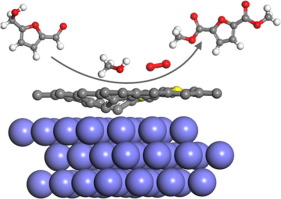Journal of Catalysis ( IF 7.3 ) Pub Date : 2019-12-18 , DOI: 10.1016/j.jcat.2019.11.029 Yunchao Feng , Wenlong Jia , Guihua Yan , Xianhai Zeng , Jonathan Sperry , Binbin Xu , Yong Sun , Xing Tang , Tingzhou Lei , Lu Lin

|
Directly oxidative esterification of Biomass-derived 5-hydroxymethylfurfural (HMF) into dimethyl furan dicarboxylate (DMFDCA) is a promising route for the replacement of petroleum-derived commodity chemical terephthalic acid (TPA) extensively employed in polyester synthesis. Co-based N-doped carbon materials are one of the most promising applied catalysts for oxidative esterification reaction, however, the active sites and reaction pathway of these catalysts have not been clearly clarified, which is crucial to the practical application. Herein, we report that ZIF-67 (a zeolitic imidazolate framework (ZIF)-type cobalt-containing MOF) derived [email protected] material is a highly effective catalyst for the selective conversion of HMF into DMFDCA in 95% yield. The high activity of the ZIF-67 derived nanocarbon composites [email protected] can be attributed to the electron transfer between nitrogen-doped carbon shells and Co nanoparticles. The appropriate graphitic N and pyridinic N doping increases the electronic mobility and active sites. Density functional theory (DFT) simulations indicated that oxygen, HMF and methanol molecules are adsorbed and activated on C-N materials. Furthermore, no 2, 5-diformylfuran (DFF) was captured as an intermediate because the oxidative esterification of aldehyde preferentially occurred than the oxidation of hydroxyl group in HMF. We anticipate that these results can drive progress in the bio-based polymers sector and oxidative esterification reaction.
中文翻译:

金属有机骨架衍生的氮掺杂碳对5-羟甲基糠醛氧化酯化反应的活性位点和催化机理的见解
将生物质来源的5-羟甲基糠醛(HMF)直接氧化酯化为呋喃二甲酸二甲酯(DMFDCA),是一种广泛用于替代聚酯合成中广泛使用的石油来源的商品对苯二甲酸(TPA)的有前途的途径。钴基氮掺杂碳材料是氧化酯化反应中最有前景的应用催化剂之一,但是,这些催化剂的活性位点和反应途径尚不清楚,这对实际应用至关重要。本文中,我们报道ZIF-67(沸石咪唑盐骨架(ZIF)型含钴MOF)衍生的[电子邮件保护]材料是一种高效的催化剂,可将HMF选择性地转化为DMFDCA,产率为95%。ZIF-67衍生的纳米碳复合材料的高活性(受电子邮件保护)可归因于氮掺杂碳壳与Co纳米颗粒之间的电子转移。适当的石墨N和吡啶N掺杂会增加电子迁移率和活性位。密度泛函理论(DFT)模拟表明,氧,HMF和甲醇分子被CN材料吸附和活化。此外,没有捕获2,5-二甲酰呋喃(DFF)作为中间体,因为醛的氧化酯化反应比HMF中的羟基氧化反应优先发生。我们预计,这些结果将推动生物基聚合物领域和氧化酯化反应的发展。适当的石墨N和吡啶N掺杂会增加电子迁移率和活性位。密度泛函理论(DFT)模拟表明,氧,HMF和甲醇分子被CN材料吸附和活化。此外,没有捕获2,5-二甲酰呋喃(DFF)作为中间体,因为醛的氧化酯化反应比HMF中的羟基氧化反应优先发生。我们预计,这些结果将推动生物基聚合物领域和氧化酯化反应的发展。适当的石墨氮和吡啶氮掺杂可以提高电子迁移率和活性位。密度泛函理论(DFT)模拟表明,氧,HMF和甲醇分子被CN材料吸附和活化。此外,没有捕获2,5-二甲酰呋喃(DFF)作为中间体,因为醛的氧化酯化反应比HMF中的羟基氧化反应优先发生。我们预计,这些结果将推动生物基聚合物领域和氧化酯化反应的发展。捕获5-二甲酰呋喃(DFF)作为中间体是因为醛的氧化酯化反应比HMF中的羟基氧化反应优先发生。我们预计,这些结果将推动生物基聚合物领域和氧化酯化反应的发展。捕获5-二甲酰呋喃(DFF)作为中间体是因为醛的氧化酯化反应比HMF中的羟基氧化反应优先发生。我们预计,这些结果将推动生物基聚合物领域和氧化酯化反应的发展。



























 京公网安备 11010802027423号
京公网安备 11010802027423号